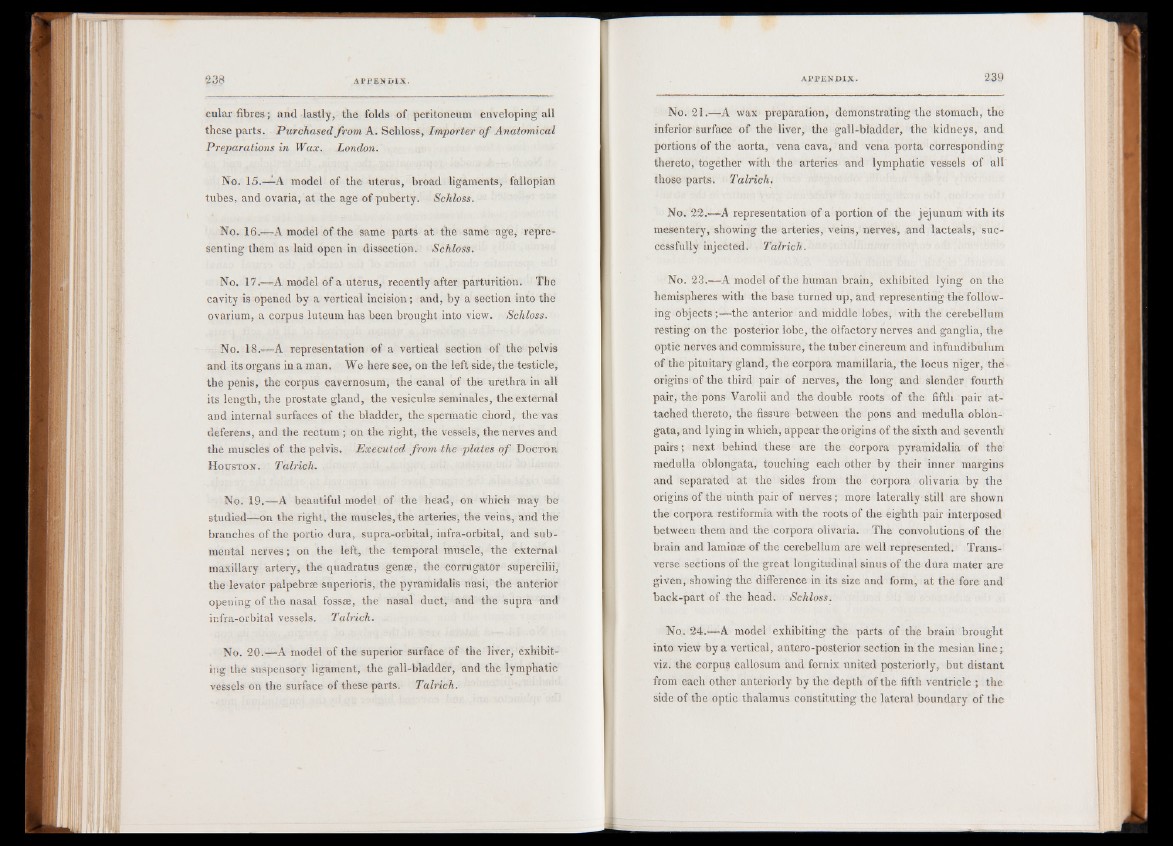
cular fibres; and lastly, the folds of peritoneum enveloping all
these parts. Purchased from A. Schloss, Importer o f Anatomical
Preparations in Wax. London.
No. 15.—A model of the uterus, broad ligaments, fallopian
tubes, and ovaria, at the age of puberty. Schloss.
No. 16.—A model of the same parts at the same age, representing
them as laid open in dissection. Schloss.
No. 17.—A model of a uterus, recently after parturition. The
cavity is opened by a vertical incision ; and, by a section into the
ovarium, a corpus luteum has been brought into view. Schloss.
No. 18.-—A representation of a vertical section of the pelvis
and its organs in a man. We here see, on the left side, the testicle,
the penis, the corpus cavernosum, the canal of the urethra in all
its length, the prostate gland, the vesiculæ séminales, the external
and internal surfaces of the bladder, the spermatic chord, the vas
deferens, and the rectum ; on the right, the vessels, the nerves and
the muscles of the pelvis. Executed from the plates o f D octor
H ouston. Talrich.
No. 19.—A beautiful model of the head, on which may be
studied—on the right, the muscles, the arteries, the veins, and the
branches of the portio dura, supra-orbital, infra-orbital, and sub-
mental nerves; on the left, the temporal muscle, the external
maxillary artery, the quadratus genæ, the corrugator supercilii,
the levator palpebræ superioris, the pyramidalis nasi, the anterior
opening of the nasal fossæ, the nasal duct, and the supra and
infra-orbital vessels. Talrich.
No. 20.—A model of the superior surface of the liver, exhibiting
the suspensory ligament, the gall-bladder, and the lymphatic
vessels on the surface of these parts. Talrich.
No. 21.—A wax preparation, demonstrating the stomach, the
inferior surface of the liver, the gall-bladder, the kidneys, and
portions of the aorta, vena cava, and vena porta corresponding
thereto, together with the arteries and lymphatic vessels of all
those parts. Talrich.
No. 22.— A representation of a portion of the jejunum with its
mesentery, showing the arteries, veins, nerves, and lacteals, successfully
injected. Talrich.
No. 23.—A model of the human brain, exhibited lying on the
hemispheres with the base turned up, and representing the following
objects;—the anterior and middle lobes, with the cerebellum
resting on the posterior lobe, the olfactory nerves and ganglia, the
optic nerves and commissure, the tuber cinereum and infundibulum
of the pituitary gland, the corpora mamillaria, the locus niger, the
origins of the third pair of nerves, the long and slender fourth
pair, the pons Varolii and the double roots of the fifth pair attached
thereto, the fissure between the pons and medulla oblongata,
and lying in which, appear the origins of the sixth and seventh
pairs; next behind these are the corpora pyramidalia of the
medulla oblongata, touching each other by their inner margins
and separated at the sides from the corpora olivaria by the
origins of the ninth pair of nerves; more laterally still are shown
the corpora restiformia with the roots of the eighth pair interposed
between them and the corpora olivaria. The convolutions of the
brain and laminae of the cerebellum are well represented. Transverse
sections of the great longitudinal sinus of the dura mater are
given, showing the difference in its size and form, at the fore and
back-part of the head. Schloss.
No. 24.—A model exhibiting the parts of the brain brought
into view by a vertical, antero-posterior section in the mesian line;
viz. the corpus callosum and fornix united posteriorly, but distant
from each other anteriorly by the depth of the fifth ventricle ; the
side of the optic thalamus constituting the lateral boundary of the